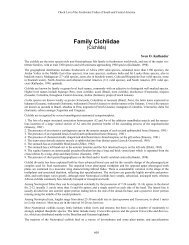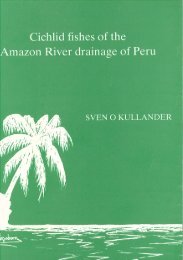Open Access PDF - Sven Kullander
Open Access PDF - Sven Kullander
Open Access PDF - Sven Kullander
You also want an ePaper? Increase the reach of your titles
YUMPU automatically turns print PDFs into web optimized ePapers that Google loves.
348<br />
fins and caudal fin margin concave. Anal and<br />
caudal fins scaled basally in 65.3 mm specimens.<br />
Colouration in preservative. Juveniles about<br />
20 mm SL yellowish white with blackish lateral<br />
band from head to caudal fin. Lateral band including<br />
an elongate blotch close behind head and<br />
another above anal fin origin, and terminating<br />
with caudad acutely tapering black spot on caudal<br />
fin base.<br />
In young specimens lateral band distinct and<br />
prominent in 56 mm SL specimen (Fig. 49), but<br />
in 65 mm SL specimen (Fig. 50) lateral band faint,<br />
affected by preservation. Three narrow brown<br />
vertical bars extending down from dorsal fin base<br />
(two below spinous portion, one below soft portion)<br />
to slightly below lateral band, widening and<br />
forming blotches where crossing lateral band.<br />
Bars 1a and 2a absent or indistinct. Dark preorbital<br />
stripe from eye to mouth. Spinous dorsal fin light<br />
with darker lappets, soft dorsal fin dusky with a<br />
few large light blotches. Caudal spot still integrated<br />
with lateral band, not ocellated, succeeded<br />
caudally by dark grey stripe.<br />
Specimens 140-150 mm SL from Marabá and<br />
Itacaiunas with distinct lateral band, emphasized<br />
preorbital stripe and midbasal caudal spot. Marabá<br />
specimen (Fig. 51) with ventral parts (underside<br />
of head, chest, belly and caudal peduncle)<br />
white, contrasting with side which greyish with<br />
yellowish tint. Head and dorsum light greyish.<br />
Grey halter stripe extending back from mouth,<br />
bordered above by white. Wide blackish lateral<br />
band slightly widened and intensified where<br />
crossing vertical bars and margined above and<br />
below by rows of white spots which partly confluent.<br />
Dark grey vertical bars 1-3, 1a, and 2a, running<br />
from dorsal fin base down to contrasted white<br />
ventral area, bars 1, 1a, 2 below spinous dorsal<br />
fin, bars 2a, 3 below soft portion of dorsal fin.<br />
Bars 1-3 wider and darker than bars 1a and 2a.<br />
Only a few, indistinct white spots on dorsum and<br />
side. Dorsal fin greyish with two rows of white<br />
spots on spinous portion and three rows of white<br />
spots on soft portion. Anal fin whitish proximally,<br />
shading to greyish distally. Caudal fin grey<br />
with large white spots in dorsal lobe. Caudal spot<br />
black and nearly completely ocellated. Pelvic fin<br />
grey anteriorly on lateral face, otherwise white.<br />
In another young specimen, 137 mm SL (Fig. 52),<br />
lateral band remaining only as black stripe on<br />
caudal peduncle.<br />
From about 150 mm SL three black spots<br />
present posterior to orbit, of which one on cheek;<br />
one, sometimes doubled, dorsally on opercle; and<br />
one, sometimes doubled, dorsally on subopercle;<br />
spots may be light ringed in large specimens.<br />
Scattered white spots appear on side, and on top<br />
and side of head, but disappear gradually again<br />
between 200 and 250 mm SL in preserved specimens.<br />
Lateral band disappears completely between<br />
150 and 200 mm SL, and vertical bars become<br />
dominant lateral markings. Number of rows<br />
of light spots in dorsal fin increasing to five.<br />
Caudal spot ocellated, ringed with whitish; 5-6<br />
vertical rows of light spots in dorsal lobe of caudal<br />
fin.<br />
Holotype, adult male 219 mm SL, not breeding,<br />
may represent average size adult colour<br />
pattern (Fig. 53). Dorsum and nape brown, gradually<br />
lighter ventrally. Underside of head and<br />
body including, chest, abdomen, narrow area<br />
close to anal fin base and underside of caudal<br />
peduncle, white, shading to yellowish. Vertical<br />
bars dark brown, bars 1, 1a, 2 from spinous dorsal<br />
fin base, bars 2a, 3 from soft dorsal fin base,<br />
wider than interspaces proximally, slightly narrower<br />
down side, ending just before entering light<br />
ventral body colour. Bars gradually slightly<br />
paler ventrally, but distinct throughout. Vertical<br />
bar absent from caudal peduncle. Dark vertical<br />
bar, similar in width and colour to posterior bars,<br />
from predorsal midline immediately anterior to<br />
dorsal fin to anterior portion of lateral line. Ocellated<br />
spots absent from side. Scattered white spots<br />
on side few and indistinct. Numerous white spots<br />
on nape, cheek and opercular bones. Indistinct<br />
narrow blackish stripe from orbit toward mouth<br />
along anterodorsal margin of lachrymal, fading<br />
anteriorly.<br />
Spinous dorsal fin in holotype dark brown<br />
with three rows of large white spots, soft dorsal<br />
fin dark brown with five rows of white spots,<br />
those in proximal row larger than rest. Anal fin<br />
yellowish basally, turning greyish distally. Caudal<br />
fin ventral half greyish, dorsal half brownish<br />
with six vertical rows of vertically elongate whitish<br />
spots. Caudal ocellus including light ring of<br />
same size as eye, black center extending between<br />
rays D1 and D3, ring between rays V1 and D4.<br />
Pelvic fin medially greyish, laterally brownish,<br />
lighter posteriorly.<br />
White spots on head and body indistinct in<br />
holotype, not at all apparent in similar sized males<br />
but more numerous and distinct in female 202 mm<br />
<strong>Kullander</strong> & Ferreira: Review of Cichla




